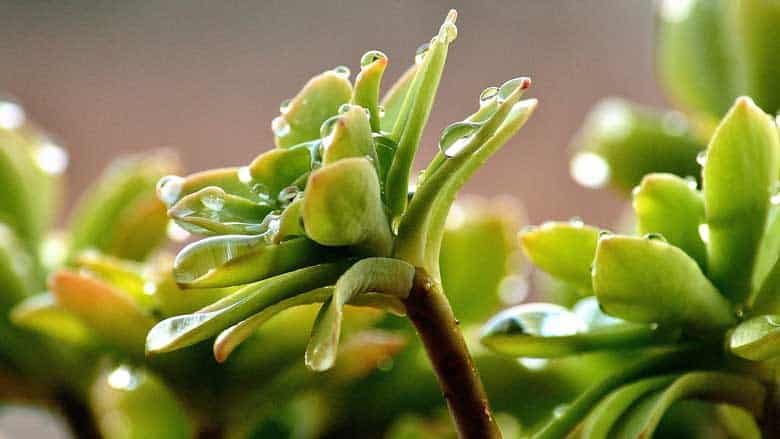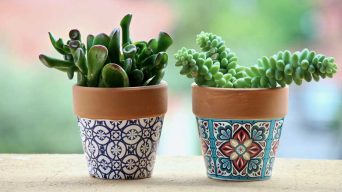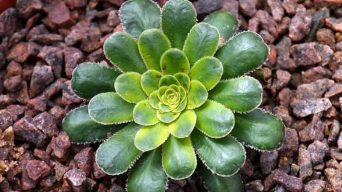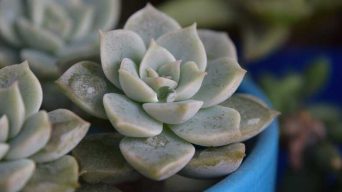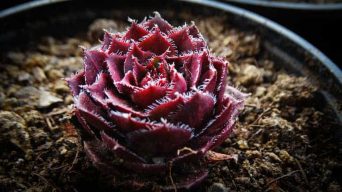Succulents are a unique and popular houseplant. They require very little care and can adapt to even the harshest of conditions.
They’re known for their tolerance to drought, but how long can succulents go without water?
It turns out that the answer to this question depends on many different factors.
Here we will explore all these things so that you can know how to care for your succulent plants properly.
How Can Succulents Survive Without Water for Long?
Succulent plants are known for their ability to survive without water for long.
They are plants that are capable of storing water in their leaves and stems. They have thick, fleshy stems and leaves due to specialized cells called “spongy parenchyma” that store water.
When succulents are exposed to less light, they open their leaves, and this is how it absorbs more sunlight for photosynthesis. Photosynthesis, in turn, produces sugar that the plant uses as food during dry periods.
This means that when there is a break from watering for weeks, succulent plants will still survive because of photosynthesis which provides them with some carbohydrates through their leaves.
These characteristics of succulents allow them to survive for long without water. They will close their leaves if they are not getting enough light, which prevents the evaporation of the stored moisture in them.
Succulents also have a waxy coating on their surface that protects against water loss when exposed to sunlight. This wax helps retain moisture by preventing evaporation from the plant’s surfaces and roots during dry periods.
Succulents can go weeks or even months without water. However, this does not mean they will survive indefinitely because when the prolonged drought takes place for a long time, it might kill them.
How Long Can Succulents Go Without Water?
In general terms, succulents can go without water for up to two weeks. Although some types of succulents, like cacti, can survive for many months without water.
The exact duration of time a succulent can go without water depends on a variety of factors, such as the plant’s type, size, and age, among others.
The larger and older a succulent plant is, for example, the longer it will be able to survive without water.
When watering your plants keep this in mind as you may have to adjust how often you are watering them based on their needs.
What Factors Determine How Long Succulents Can Go Without Water?
It’s not possible to know the exact amount of time as it depends on various factors. The actors that will affect how long succulents can go without water are the following:
Type of Succulent
There are many succulents to choose from, and each type has a different water needs. Succulent leaves will dry up if they do not get enough moisture.
Hence, it would help if you remembered how often your specific plant needs watered according to its type.
- Echeveria: this is one of the most popular types of succulent, but it does need frequent watering because its soil dries out quickly.
- Jade Plant: these plants can survive on infrequent deep watering cycles that occur about once per month or even less frequently in some cases. However, when planting them, make sure the ground is well-draining and remains moist at all times.
- Aloe Plants: like jade plants, aloes require infrequent watering, but they need more water when in bloom because the flower is heavier and needs extra hydration.
- Other succulents: If you have other types of succulent plants, it would be best to research how often they require to be watered based on their specific needs.
Succulent Size and Age
The size and age of the succulent determine how long they can go without water. Smaller, newer plants are generally more hardy than larger, older ones.
Succulents that have been in a pot or garden bed for many years may be too old to survive even one day without water.
If your plant is very young (<= 12 weeks), it should be able to withstand several days of drought conditions before showing severe signs of stress.
This gives plenty of time for an attentive person with a green thumb to provide their succulent some much-needed care; if not given water, the succulent will eventually die.
If your succulent is of average age (12 to 18 weeks), it can go without water for about a week before showing severe signs of stress. This gives you plenty of time to get some emergency watering in there and save the plant from death by dehydration.
Finally, if your succulents are older than one year old (>18 weeks) or very large, they may only be able to withstand two days without hydration.
After this amount of time soaking up nothing but the hot sun and scorching heat, most plants’ roots will have died from dehydration.
Indoor and Outdoor Environmental Conditions
The succulent’s environment also determines how long it can go without water.
If you live in a dry climate, your plant will need more water because the heat dries out its soil faster than if you lived somewhere humid like Florida or Hawaii.
The amount of sunlight and wind also play a part in determining when to water as well, so adjust accordingly.
We need to consider that the conditions for growing succulents indoors are different from growing them outdoors.
Indoors Conditions
1. Light
Succulents require a lot of light to stay healthy.
If indoor succulents are not getting enough sun, they can only last for about two weeks without water before the leaves start to die off and turn brown.
2. Humidity
Succulent plants need high humidity levels to survive for long periods without being watered. This is because their cell walls remain soft and moist when they have adequate moisture levels around them.
Indoor air is usually dryer than outdoor air, which means that indoor conditions may be too harsh on succulents if you neglect watering them regularly during these times.
3. Temperature
The most crucial factor indoors is temperature. Unlike people, succulents cannot thermoregulate themselves by producing sweat or shivering.
Thus, it would help if you placed succulents in a relatively cool room where the temperature is between 55 and 75 degrees Fahrenheit or about 18 to 24 degrees Celsius. Colder temperatures being more appropriate for the winter months.
Outdoors Conditions
1. Light
Succulents should be watered more frequently in outdoor conditions, especially if they are exposed to direct sunlight.
2. Humidity
The amount of moisture in the air is also important, but this varies depending on where you are.
You should water outdoor succulents more frequently if they’re exposed to extreme humidity or dryness for prolonged periods.
3. Wind
Windy conditions can lead to rapid dehydration and desiccation.
4. Rainfall
The frequency by which succulents need water depends mainly on how much rainwater it receives.
Succulents that live in areas with plenty of rainfall may not need watering every day. In contrast, those living in an area with little rain might require daily watering.
5. Topography and Elevation
Various topographical factors will affect a plant’s ability to retain water, like altitude, slope, orientation towards sun exposure, and soil composition.
6. Temperature
Unlike indoors, where the temperature is most important, outside it is the amount of sunlight that determines how much water your succulents will require.
The sun’s energy evaporates moisture from plants’ leaves, so hotter climates mean you have to water plants more often.
Type of Pot
The type of pot the succulent is in can determine how long it will survive without water.
The size and material of the pots that are used to grow succulents play a role, as well. Plastic containers work better than clay because they retain moisture longer, even without watering them.
Wooden planters also work well, but less so if you have animals around who could chew on the wood, damaging your succulent roots.
The size of the pot and whether or not it has drainage holes will decide how often a succulent needs water.
The pot needs to be big enough for the plant’s roots and have drainage holes so that water doesn’t become stagnant.
The soil should also not be too dry, or else it will wither away, but neither can it be soaked because then your succulent is unable to breathe through its leaves.
Type of Soil
The quality and type of soil mix can impact how long succulents can survive without water.
For instance, cacti are desert-dwelling plants that don’t need much water and thrive in hot climates with low levels of rainfall. Therefore, they require a type of potting mix that is typically very well-drained, so it doesn’t hold too much moisture.
High-quality succulent soil mix, which includes a combination of different materials like peat moss and vermiculite, is typically well-drained.
If not properly watered on time, these soil types will become too dry for succulent roots to absorb any moisture from it.
In this case, the plant may be able to survive without water for days or even weeks until someone notices that there’s an issue with how long they’ve been left unattended.
It’s essential when caring for succulents that are native to desert climates that you use a potting mix that is well-drained such as cactus soil.
This will help the roots absorb moisture more easily from moist soil, meaning less water will need to be given at any one time.
This also means if there isn’t enough water available during drought periods, then these specific succulents should fare much better than those succulents grown in regular potting soil.
Regular soil doesn’t drain as quickly and can become saturated with too much moisture and rot away or dry out in extreme conditions.
Seasonal Factors
When succulents are dormant during the winter, they need less water. It is normal for them to stop producing their leaves and storing up nutrients in those leaves during this time of year.
Naturally, when they don’t produce these leaves or store as many nutrients there, they also won’t require as much water. This translates into a reduced watering frequency from once every week to just three times per month during this period.
The same factors apply to autumnal dormancy periods, too. Except that you should reduce watering down to two weeks rather than one month, especially if your climate isn’t rainy enough for plants like succulents.
During these periods of dormancy, succulents will require less food and consequently less water too.
During its active growing phase, which is in the summer, succulents need to be watered more often to keep the roots from drying out and to provide the necessary nutrients for them to grow.
This means that during this period, you’ll be watering your succulents more often – usually once every week to just three times per month during this period.
In the summer, these plants can also be vulnerable to dehydration if there is not enough rain or irrigation.
This means that their caretakers must monitor how much water each plant needs and provide adequate access to drinking water at all times.
Even in humid climates where succulents may seem like they don’t need it.
How To Know When To Water Succulents?
There isn’t one perfect answer for how often you should be watering your succulents, but we’ll cover some tips and tricks below.
- If a succulent is potted in soil, then you should water the plant when the top of its soil feels dry to touch.
- You can also use your finger to poke about an inch into the potting mixture and check how wet it is. If there’s still moisture present at this depth after three days without watering, then that means it needs more water.
- If a succulent is potted in gravel, then poke your finger down into the potting medium and make sure it’s moist at least halfway to the bottom of the pot. If not, you can add just enough water so that there are no dry spots.
- You can also use a soil moisture meter to measure how much water is in the potting mixture.
If these methods don’t work for you, you can tell if your succulent is underwatered by observing one or more of the signs listed below.
Signs of Underwatered Succulents
Common signs of a succulent suffering from underwatering include:
- The leaves are drooping, discolored, or curled upwards
- If there are wrinkles in the leaves
- If you touch the succulent, it is soft and mushy to the touch. This can also manifest as a dark green “splotch” on top of the soil
- The roots are dark brown or black and mushy
- The succulent is limp to the touch
- The succulent may shrivel or shrink
- Leaves may start to drop off from the plant, but not all of them at once.
- In extreme cases, the leaves may turn yellow.
If you notice these signs, then give your succulent some water right away!
You should try to keep them from getting too dry to prevent this type of damage from happening again next time they go without water.
Final Thoughts
Watering succulents can be a bit of an art because it’s not as simple as watering them every day.
It is important to remember that succulents have different water needs. Some may require less frequent watering than others, depending on the type of succulent itself or how you care for it.
In general, most types need between three to four weeks before they start showing dehydration symptoms: leaf color changes and wilting leaves.
However, this will vary based on their growing conditions.
Ultimately, succulents are adapted to desert environments, which means that they can go weeks without watering and only need a little bit of water every now and then.
If you find yourself needing to travel for more than two or three days, make sure the soil is moist before leaving it unattended.

